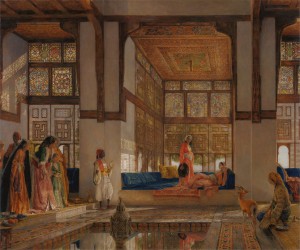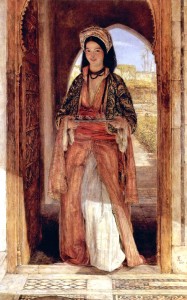Zaida of Seville
From the eighth to eleventh centuries, the greater part of what is now Spain and Portugal was under Moorish rule, the vast Muslim province of al-Andalus. The Christians huddled in their enclaves in the far north of the peninsula, until a succession of vigorous kings brought the Reconquista to its southernmost shores, reducing the once-mighty Caliphate of Córdoba to a handful of tiny taifas or republics.
The Taifa of Seville, for example, was created in 1031 by its former qadi or governor who, declaring his independence from the Caliphate, reigned there as Abbad I. The third and last Emir of Seville, Abbad’s grandson Muhammed ibn Abbad al Mu’tamid, was thus the ruler not of a glorious Islamic capital but of a tiny, weakened outpost beset by powerful enemies.
Crippled by tribute to the Christian king of Castile, al Mu’tamid rashly appealed to the Almoravids of Morocco for help. By 1091, the Almoravids had themselves occupied the remaining Islamic taifas. Seville was besieged and captured, al Mu’tamid ordering has sons to surrender the Alcazar or citadel in exchange for their lives. He himself died mysteriously in exile at Aghmat, in Morocco, in 1095.
Another of al Mu’tamid’s sons, Abu Nasr al-Fath al Ma’mum, Emir of the Taifa of Córdoba, had perished in March 1091 during the siege of that city, but had previously sent his wife, Zaida, and his children to Almodóvar del Rio, where they had sought the protection of Alfonso VI ‘El Bravo’, the Christian King of Castile. No details are known, but the widowed Muslim princess had caught the fancy of the lusty king, whose mistress she had become, though he had also been prompt in arranging for her baptism in the name of ‘Isabella’.
Isabella, formerly Zaida, duly gave birth to Alfonso’s beloved only son, Sancho, whose death at the Battle of Uclès in 1108 was to career Alfonso, broken-hearted, to a premature grave. Some say that Alfonso later married her, for his fourth wife, who died in childbirth, was also called Isabella and her identity is otherwise unknown. If so, Zaida was also the mother of Elvira and Sancha, the two daughters of that marriage. These two girls were to become the wives respectively of Rodrigo González de Lara, a Castilian nobleman and crusader who died in the Holy Land in 1143, and of Roger II, Count of Sicily. From both couples there are numerous lines of descent to the present day. (See, for example, the table of descent from Sancha of Isabella of Castile, wife of Edmund, Duke of York, in Iain Moncreiffe and Don Pottinger, Blood Royal (Edinburgh, 1956), p.16.)
It was asserted by Bishop Pelayo of Oviedo (died 1135), in his Chronicon Regum Legionensium, that ‘Ceida’ was in fact the daughter of King ‘Abenabeth’ of Seville (al Mu’tamid), but this authority is expressly contradicted by the more reliable Islamic sources. Pelayo’s account has nevertheless given rise to a persistent myth about Zaida, whom a much-later tomb inscription confidently describes both as ‘uxor regis Adefonsi’ and as ‘filia Benabet’. For what it is worth, Pelayo of Oviedo does not speak of her as queen, but as one of Alfonso’s ‘duas concubinas’.
The scholarly consensus is that Zaida was indeed al Mu’tamid’s daughter-in-law and that her parentage is unknown. Her identity with the later Queen Isabella is ‘undetermined’. It is unlikely that the truth of the matter, and whether she was indeed the mother of Elvira and Sancha, will ever now be revealed.
(Evariste Lévi-Provençal, ‘La “Mora Zaida”, femme d’Alfonse VI de Castile, et leur fils l’Infant Sancho’, Hesperis 18 (1934), pp.1-8, 200-1; Alberto Frutos Montaner, ‘La Mora Zaida, entre historia y leyenda’, in Barry Taylor and Geoffrey West eds., Historical Essays on Hispano-Medieval Narrative (London, 2005), pp.273-352.)
Madragana of Faro
In contrast to the case of Zaida of Seville, lines of descent from another Andalusian, Madragana of Faro, are well established.
The Reconquista had continued apace and, in 1249, a final assault was launched on the remaining Muslim enclaves in Portugal. The Crónica da Conquista do Algarve describes the capture of Faro by the Portuguese king, Afonso III. The city had fallen without fuss, Afonso promising the Moors that they would enjoy ‘the same laws in all things as they had received from their own king’, and that they would retain ‘all their houses, vineyards and inheritances’. They were free to move to other Moorish lands if they wished, taking their goods with them. Those who remained would become his vassals and would be treated with ‘honour and mercy’.
As a modern historian observes, these ‘businesslike negotiations were carried through without any indication of culturally based animosity’ (Stephen Lay, The Reconquest Kings of Portugal (London, 2008), p.258). By the end of 1250 the remaining Muslim strongholds had all surrendered to Afonso’s forces, having wearily resigned themselves to the inevitable. The Portuguese Reconquista was thus complete.
According to medieval sources, Afonso, having deposed Aloandro, the last qadi (governor) of Faro, had taken his daughter, Madragana, as his mistress. She had at once been baptised in the name of ‘Mor Afonso’, ‘Mor’ being short for Maior, a common female name in medieval Portuguese. The patronymic ‘Afonso’ denotes that she was the ‘daughter of Afonso’, the king himself presumably acting as godfather. Other sources refer to the girl as Mourana, a version of Ouroana which is another traditional Portuguese name.
The sources are very clear that Madragana bore two children by Afonso: a son, Martim Afonso Chichorro, born about 1250, and Urraca, born about 1260. Eventually, the royal passion seems to have waned and Madragana was married off to one Fernão Rei, whose surname (‘of the king’) suggests that he had been employed a servant at the court.
Madragana’s son Martim was married in 1274 to Inès Lourenco de Sousa de Valadares and founded the house of Sousa-Chichorro. The Duke of Lafões is its head and it is said that all the great families of Portugal can claim Sousa ancestry. So too, can many families in northern Europe, for a contingent of Sousas accompanied their cousin, Isabella of Portugal, to the Netherlands in 1429 for her marriage to Duke Philip the Good of Burgundy. Two years later, Isabella de Sousa-Chichorro, daughter of Afonso-Vasques, married one of Philip’s nobles, Jean de Poitiers-Valentinois, lord of Arcis-sur-Aube, near Troyes, and of Vadans in the Franche-Comté; while her niece, Marguerita de Castro e Sousa, was soon to marry another Burgundian lord, Jean de Neufchatel, Lord of Montagu and Fontenoy.
The Poitiers lords of Vadans are the subject of a previous blog (http://www.rupertwilloughby.co.uk/gleanings/the-flight-of-la-vouivre-from-dole-to-vadans-reflections-on-the-house-of-poitiers-valentinois/). I myself am descended from them, and from Madragana, through my great-grandmother, a franc-comtoise. It is from Marguerita de Castro y Sousa that the modern British royal family descends. Her granddaughter, Antoinette de Neufchatel, married Philipp, Graf von Salm. Antoinette’s daughter in turn married a Graf von Erbach. Four generations later, Sophie Albertina von Erbach married a Prince von Sachsen Hildburghausen. Their granddaughter, Charlotte von Mecklenburg-Strelitz, was George III’s queen and the grandmother of Queen Victoria (https://upload.wikimedia.org/wikipedia/commons/0/0b/Margarita_de_Castro_e_Souza_genealogy_and_descent.JPG).
This tenuous link has given rise to much tendentious, indeed ludicrous speculation about the genetic make-up of the modern royal family, especially in the light of Prince Harry’s marriage to Meghan Markle. Madragana has unhistorically been described as ‘black’, and her remote descendant, Queen Charlotte, as ‘Britain’s first black queen’, especially as her ‘negroid’ features were often commented upon. Queen Charlotte is even listed by campaigners among ‘100 Great Black Britons’, along with such luminaries as Diane Abbott and Joan Armatrading (http://100greatblackbritons.com/bios/queen_charlotte.html).
A soi-disant ‘historian of the African diaspora’, Mario de Valdes y Cocom, has gone so far as to describe the Sousas as ‘a black branch of the Portuguese royal house’ (Mario de Valdes y Cocom, ‘The Blurred Racial Lines of Famous Families’, https://www.pbs.org/wgbh/pages/frontline/shows/secret/famous/royalfamily.html). A more reasonable presumption is that the ancestors of Madragana were from north Africa, possibly blue-eyed Berbers or even Vandals, a Germanic tribe who had settled there. There are even claims that the family was Jewish, descended through the Exilarchs of Babylon from King David himself (Manuel Abranches de Soveral, ‘Origen dos Souza ditos do Prado’, in Machado de Vila Pouca de Agular (Porto, 2000)). They may have been distantly descended from Jews and indeed from sub-Saharan Africans – the current fad for DNA testing reveals many surprises – but, by any stretch of the imagination, it is a ridiculous distortion to describe Queen Charlotte, the Sousas or even Madragana herself as ‘black’.
[Duarte Nunez do Lião, Primeira parte das Chronìcas dos reis da Portugal (cota RES, 574v, p.97; António Caetano de Sousa, História Genealógica da Casa Real Portuguesa, Tomo XIV, Parte III (Lisbon, 1600), pp.702-3: ‘Alguus differaõ, que fora sua mãy Moura, como foy o Desembargador Duarte Nunes de Leaõ, o que segnio o Chronista Fr. Antonio Brandaõ, dizendo ser filha de Aloandro, hum dos Alcaides de Faro, quando El Rey ganhou esto Cidade no ano de 1250, e que sendo dotada de grande fermosura, El Rey tivera trato com ella’. For the wilder theories see Stuart Jeffries, ‘Was this Britain’s First Black Queen?’, The Guardian (Race Issues section), 12 March 2009; Doreen, Lady Lawrence also alluded to Prince Harry’s ‘black’ ancestress, Ouroana, on Radio 4 the day after his wedding.]

